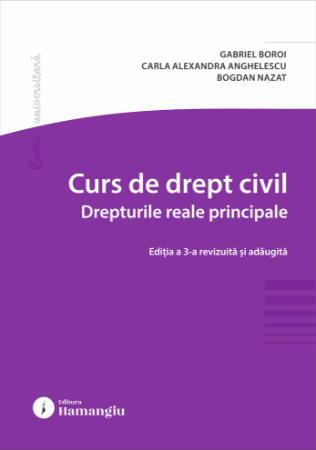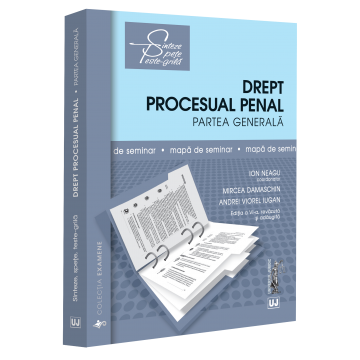Propuneri manuscrise: [email protected]: 0745 204 115
Urmărire comenzi Persoane fizice / Vânzări: 0745 200 357 / Comenzi Persoane juridice: 0721 722 783
ISBN: 978-606-591-021-8
Anul publicării: 2010
Ediția: I
Pagini: 192
Editura: Editura Universitară
Autor:
- Descriere
- Download (1)
- Autori
- Cuprins
- Cuvânt înainte
- Review-uri (0)
This book is designed to be a succinct exposition of American criminal law. The brief text is intended primarily for use by both American and Romanian law students taking courses in the field of criminal law, and also by those interested in learning more about American criminal law. It can be a start in going deeply into the subject. It is also designed as a foundation for excellent exam performance for American students. Once they are familiar with the theory questions, answers and definitions, they can face their Criminal Law exam with the confidence of knowing and understanding every principle and being able to recognize issues in context.
American Criminal Law is the study of the elements which must be satisfied to find that a person has committed a crime. It deals with the four basic elements of all crimes: a voluntary act, a culpable intent, a confluence of act and intent, and causation.
The book is divided into eight chapters. Chapter 1 defines Criminal Law and makes us acquainted with what criminal law does. Chapter 2 is concerned with the ingredients of all crimes (mens rea and actus reus). Chapter 3 and chapter 4 discuss inchoate and group criminality, respectively. Chapter 5 discusses capacity, while Chapter 6 discusses defenses. Chapters 7 and 8 develop those specific crimes which, in the opinion of the author, need developing. In addition, it analyzes causation and self-defense. Finally, the book concludes with a short perspective on the study of criminal law.
Within each chapter, there are two sections: A. Reading Section, containing theory questions, answers and/or definitions and, B. Practice Section, containing hypotheticals that teach you how to apply specific legal principles to the level of detail tested on American law school exams and the American Multistate Bar Examination.
‘Perspective’ wants to be a final word of encouragement for those interested in studying American criminal law and who must know that studying law is a never inauguration but also a continuous exploration of this field.
The English-Romanian Criminal Law Vocabulary Section, with which the volume continues, could be helpful and stimulating for our students of English making them understand faster and better the meanings of the words, sentences and phrases usually used in criminal law terminology.
‘References to Source Materials’ ends the volume.
-
American Criminal Law: An Introduction for Law Students of English
Descarcă

Anca Magiru este doctor in filologie din 2004, Universitatea din Iasi, cu teza de doctorat, The Morte Darthur: A Myth and Its Metamorphoses, sub conducerea stiintifica a domnului profesor dr. Stefan Avadanei (2006, Editura Cartea Universitara, Bucuresti), absolventa a Facultatii de Invatamant Pedagogic (engleza - franceza), Universitatea din Galati, si a unor cursuri de specializare in tara si in strainatate; beneficiara a bursei Soros, la Institute for Applied Language Studies, Universitatea din Edinburgh, Scotia, si a bursei Socrates, la Management & Language Specialists International Institute din Bournemouth, Anglia. De peste 10 ani preda cursuri de limba engleza juridica la Facultatea de Drept si Administratie Publica Constanta din cadrul Universitatii Spiru Haret. Este absolventa Fulbright 2008-2009, cu un proiect international postdoctoral (in calitate de director), de cercetare in domeniul dreptului american, la St. Mary's University School of Law, San Antonio, Texas. Pentru o cooperare bilaterala romano-americana, a initiat si organizat vizita profesorului american de drept Vincent R. Johnson de la St. Mary's University School of Law, San Antonio, Texas, la Universitatea Spiru Haret, Facultatea de Drept si Administratie Publica Constanta, 9-16 octombrie 2010. Carti publicate in domeniul juridic, ca autor unic: 2011. English for Law Students, Editura Universitara, Bucuresti. 2011. English for Public Administration Students, Editura Universitara, Bucuresti. 2010. American Criminal Law: An Introduction for Law Students of English, Editura Universitara, Bucuresti. 2006. Equal Justice Under Law. Ed. Europolis, Constanta. 2003. The Law and the Judiciary in the Anglo-Saxon World, Ed. Cartea Aromana, Constanta. 2001. Juvenile Crime in the United States of America , Ed. Europolis, Constanta.
Introduction / 7
References, Abbreviations and “Notes” / 9
Acknowledgments / 11
Chapter 1 General Principles / 13
Chapter 2 Act & Intent / 24
Chapter 3 Accomplice Liability / 40
Chapter 4 Inchoate Crimes / 50
Chapter 5 Capacity / 72
Chapter 6 Defenses / 85
Chapter 7 Crimes Against the Person / 99
Chapter 8 Crimes Against Property / 129
Perspective / 159
EnglishRomanian Criminal Law Vocabulary / 162
References to Source Materials / 189
This book is designed to be a succinct exposition of American criminal law. The brief text is intended primarily for use by both American and Romanian law students taking courses in the field of criminal law, and also by those interested in learning more about American criminal law. It can be a start in going deeply into the subject. It is also designed as a foundation for excellent exam performance for American students. Once they are familiar with the theory questions, answers and definitions, they can face their Criminal Law exam with the confidence of knowing and understanding every principle and being able to recognize issues in context.
American Criminal Law is the study of the elements which must be satisfied to find that a person has committed a crime. It deals with the four basic elements of all crimes: a voluntary act, a culpable intent, a confluence of act and intent, and causation.
The book is divided into eight chapters. Chapter 1 defines Criminal Law and makes us acquainted with what criminal law does. Chapter 2 is concerned with the ingredients of all crimes (mens rea and actus reus). Chapter 3 and chapter 4 discuss inchoate and group criminality, respectively. Chapter 5 discusses capacity, while Chapter 6 discusses
defenses. Chapters 7 and 8 develop those specific crimes which, in the opinion of the author, need developing. In addition, it analyzes causation and self‐defense. Finally, the book concludes with a short perspective on the study of criminal law.
Within each chapter, there are two sections: A. Reading Section, containing theory questions, answers and/or definitions and, B. Practice Section, containing hypotheticals that teach you how to apply specific legal principles to the level of detail tested on American law school exams and the American Multistate Bar Examination.
‘Perspective’ wants to be a final word of encouragement for those interested in studying American criminal law and who must know that studying law is a never inauguration but also a continuous exploration of this field.
The English‐Romanian Criminal Law Vocabulary Section, with which the volume continues, could be helpful and stimulating for our students of English making them understand faster and better the meanings of the words, sentences and phrases usually used in criminal law terminology.
‘References to Source Materials’ ends the volume.

6359.png)
![American Criminal Law: An Introduction for Law Students of English [1] American Criminal Law: An Introduction for Law Students of English [1]](https://gomagcdn.ro/domains/editurauniversitara.ro/files/product/large/american-criminal-law-an-introduction-for-law-students-of-english-2175-884040.jpg)















